Generally, millets are small-grained, annual, warm-weather cereals belonging to the grass family. They are highly tolerant of drought and other extreme weather conditions and have a similar nutrient content to other major cereals. Millet is desirable for human food because it is easily digestible and gluten-free. It can be ground into flour, used to bake flatbreads, used to make tabbouleh, or for brewing beer. The different species of millets are not necessarily closely related. All are members of the family Poaceae (the grasses) but can belong to different subfamilies.
- Finger Millet (Eleusine coracana)
- Foxtail Millet (Setaria italica)
- Browntop millet (Urochloa ramose)
- Pearl Millet (Pennisetum glaucum)
- Japanese millet/Barnyard Millet (Echinochloa esculenta)
- Little Millet (Panicum sumatrense)
- Broomcorn Millet/Proso Millet (Panicum miliaceum)
- Kodo Millet (Paspalum scrobiculatum)
- Fonio millet (Digitaria exilis)
- Guinea millet (Brachiaria deflexa)
- Great Millet (Sorghum bicolor)
- Sonoran millet (Panicum hirticaule)
- Polish Millet (Digitaria sanguinalis)
- Adlay Millet (Coix lacryma-jobi)
- Taiwan oil millet (Spodiopogon formosanus)
Classification of Millets
Millets are broadly divided into two major categories-naked and husked grains:
- Naked variety: The predominant varieties under this category include finger millet, pearl millet, and sorghum. They do not contain any of the hard indigestible husks in them. This means that they do not need to be processed after they get harvested. They can directly be used after they are cleaned.
- Husked variety: The husked ones, on the contrary, contain an indigestible seed coat, which cannot be consumed until and unless the husk is removed. These include kodo millet, foxtail millet, and little millet among others.
Types of Millet
Finger Millet

Finger millet is a robust tillering grass which grows in tufts. It has erect, light green stems. The leaves of the plant are dark green, linear and mainly smooth with some hair along the leaf edges. The inflorescence of the plant is a cluster of 3–26 ‘fingers’ composed of dense spikelets where the grain, or seed, is produced. Finger millet can reach 1.7 m (5.6 ft) in height and is an annual plant, harvested after one growing season.The seeds, which may be white, light brown, or dark brown, are consumed in a variety of forms including as unleavened bread made from milled flour. Various types of porridge and alcoholic beverages are also prepared from the seeds. Finger millet may also be referred to as African fingermillet, goosegrass
Foxtail millet
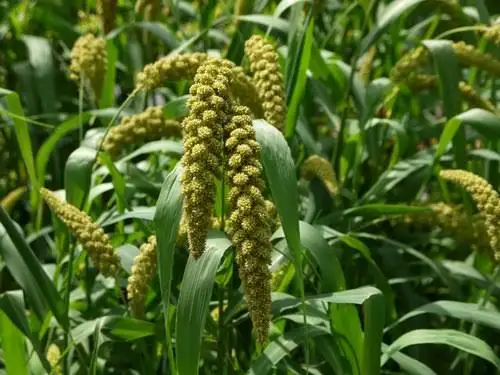
Foxtails are so named for their spikelet clusters of bristled seeds, which are dispersed as a unit and somewhat resemble the bushy tail of a fox. Foxtail millet is thought to be native to Southern Asia and is considered one of the oldest cultivated millets. It is an annual, warm-season crop that grows 2-5 feet tall. The stems are course and leafy, and more slender than those of pearl millet. It can form one or more tillering shoots. The yellowish or purplish nodding inflorescence is composed of a main stalk with many side branches. The deadheads are dense and bristly and the oval, convex seed grain can be a variety of colours.
Also Read: Different Types of Edible Pumpkins
Pearl millet
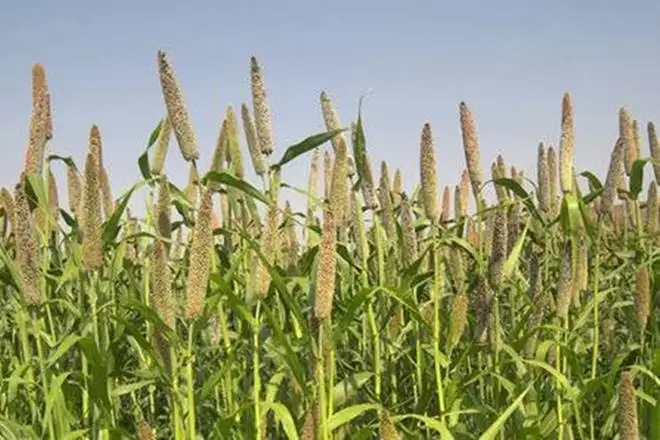
Pearl millet is a very robust grass which tillers widely and grows in tufts. It has slender stems which are divided into distinct nodes. The leaves of the plant are linear or lance-like, possess small teeth and can grow up to 3.3 feet in length. The inflorescence of the plant is a spike-like panicle, made up of many smaller spikelets where the grain is produced. Pearl millet can reach 1.5–13 feet in height depending on the cultivar and is an annual plant, harvested after one growing season. Pearl millet may also be referred to as bulrush millet, cat-tail millet or yellow bristle grass.
Guinea Millet
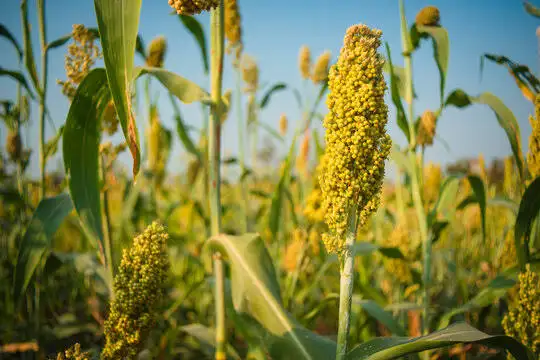
Guinea millet is an annual grass that grows up to 70cm tall. It has weak and slender stems that are finely pubescent. The stem extends into roots at the lower nodes. Leaves alternate across the stem and are a linear-lanceolate shape with a pale leaf sheath. Inflorescence imitates a panicle with 7-15 racemes on a 6-15 cm long axis. These recemes are broadly elliptical and have spikelets up to 15mm long. It matures in 90-130 days and flowers throughout the year.
Japanese millet
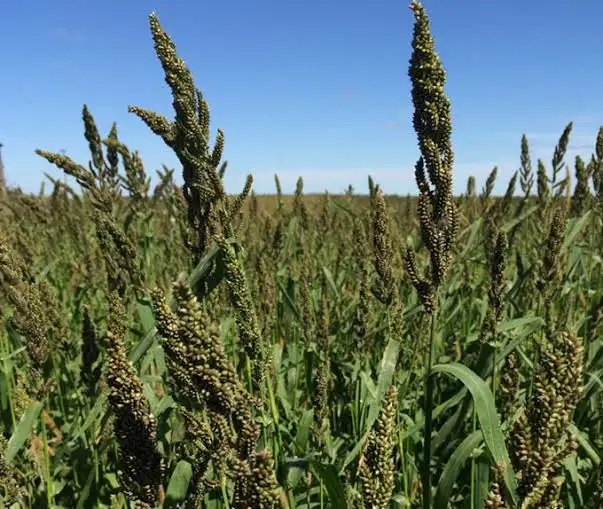
Japanese millet is an annual, warm-season grass that is grown primarily as forage and wildlife habitat in the United States. This plant can grow to 60″ (1.5 m) in height and has long, flat leaves which are often purplish at the base. Most stems are upright, but some will spread out over the ground. Stems are flattened at the base. The seed heads are a distinctive feature, often purplish, with large millet-like seeds in crowded spikelets. The spikelets are awnless, slightly warty, with bristly nerves. Japanese millet is also suited for silage, but not for hay. It is fed green to animals and provides fodder throughout the year; hay made from this plant can be kept up to 6 years.
Little Millet
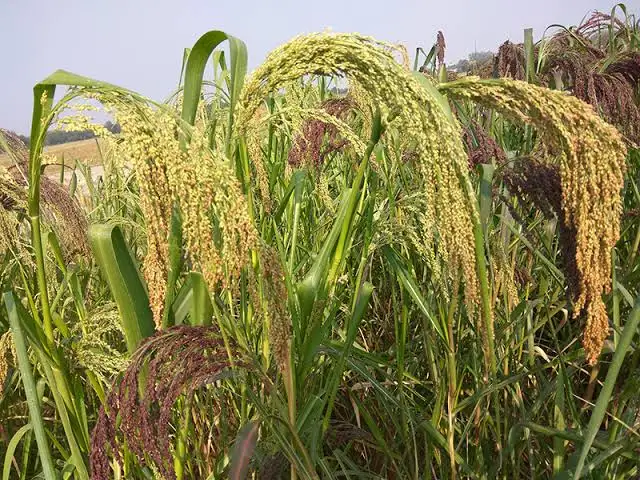
The Little Millet is believed to have originated in India. It is grown and used for food almost many countries in Africa, Asia and India. This species of cereal is similar in habit to the proso millet except that it is smaller. It is an annual herbaceous plant, which grows straight or with folded blades to a height of 30 centimetres. The leaves are linear, with the sometimes hairy laminae and membraneous hairy ligules. The green plant can also be used in part as cattle feed. The straw can be mixed with clay or cement be used in construction.
Also Read: Different Types of Edible Mushrooms
Proso Millet
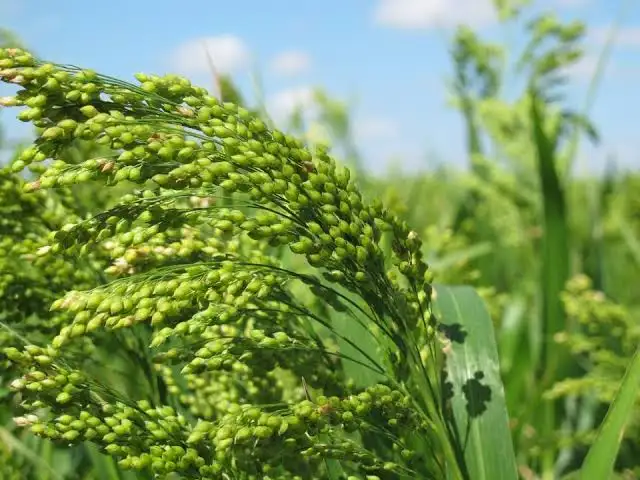
Proso Millet is a warm-season crop capable of producing seeds 60 to 90 days after planting. It is also referred to as common millet, hog millet, broom corn, yellow hog, hershey and white millet. It has been grown in many countries including China, Ukraine, Russia, Africa and India. The grains are primarily used for human consumption. The whole grains are boiled, roasted, cooked into porridge, ground, baked into flat bread or chapatti.
Proso millet is often planted as an emergency cash crop for situations where other crops have failed, been hailed out or were never planted due to unfavorable conditions. Proso millet may also be beneficial in a crop rotation. In a rotation, it has the advantage of enhancing weed control, especially with winter annual grasses in winter wheat.
Kodo Millet
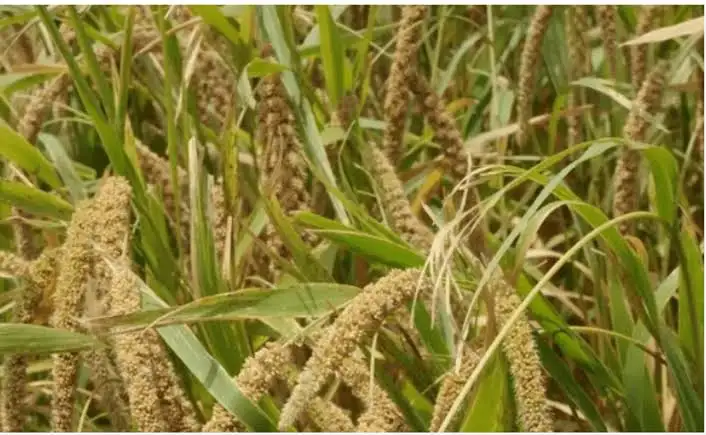
Kodo Millet is a monocot tufted annual or perennial grass that grows up to 150 cm tall. The plant typically occurs in seasonally flooded areas and wet depressions, often association with cultivation and settlements, such as along roadsides, ditches, and waste ground and rice fields. Stems are rather stout, not or sparingly branched, glabrous or thinly furnished with rather long hairs. Blades are pale green whereas the leaf sheaths and leaves are glabrous. The seeds it produces are very small and ellipsoidal, being approximately 1.5 mm in width and 2 mm in length; they vary in color from being light brown to a dark grey. The plant has shallow root system which may be ideal for intercropping.
Also Read: Cassava Varieties and How To Grow
Fonio Millet

Fonio also referred to as ‘hungry millet’ or ‘hungry rice’ is type of millet widely cultivated in West Africa. Fonio may be Africa’s oldest cultivated cereal crop, with an ancient lineage going back more than 5,000 years. Archeologists have even found it buried in tombs in the Egyptian pyramids. White fonio is mainly cultivated from Senegal to Chad while black fonio is grown mainly in Nigeria as well as the northern regions of Togo and Benin.
Fonio is an annual plant with a plant height of 45–50 cm. The roots are well developed and attached firmly to the soil. The inflorescence is composed of two to six fingers of 5–12.5 cm length. Fonio yields very small kernels that are milled into flours, which are mainly used for preparation of porridges, couscous, traditional breads, and opaque beers. The grain can be added to stews, or boiled and eaten with palm oil. Fonio can also be used for brewing beer. In comparison with other cereals, fonio has a poor nutritional value in terms of total protein and amino-acid balance.
What you need to know about Millets
- Millet develops slender stem divided in nodes. It can reach from 1 to 15 feet in height, depending on the variety.
- Millet has simple, lanceolate leaves, toothed on the edges. Leaves are hairy and alternately arranged on the stem.
- Millet produces miniature flowers arranged in spikes (type of inflorescence composed of large number of individual flowers without stalks).
- Fruit of millet are grains. Kernels are miniature, obovate, globular, hexagonal, elliptical or lanceolate in shape. They can be white, yellow, grey or red in color.
- Some of the best known and most widely used types of millet are: pearl millet, foxtail millet, proso millet and finger millet.
- Millet is rich source of dietary fibers, vitamins of the B group, calcium, iron and magnesium.
- Millet can be consumed as part of breakfast cereals, in the form of porridge or as an ingredient of soups, stews and breads.
Also Read: Major varieties of Kales to grow at home
General uses and benefits of Millets
- Regular consumption of millet is very beneficial for postmenopausal women suffering from signs of cardiovascular disease, like high blood pressure and high cholesterol levels.
- Millet helps hydrate your colon to keep your system regular and keep you from being constipated.
- Millet helps in controlling Blood sugar and Cholesterol.
- It is easy to digest, contains a high amount of lecithin and is excellent for strengthening the nervous system.
- It is rich in photo chemicals, phytate that helps in reduction of cancer risks.
- It helps to reduce the body weight and beneficial for postmenopausal women.
- It is good for those suffering from signs of cardiovascular disease, like high blood pressure and high cholesterol levels.
- Also, it is good for diabetics, its anti – diabetic compounds like quercetin, ferulic acid, p – hydroxybenzoic acid, vanillic acid and syringic acid from Varagu prevents obesity.
- Millets contain no gluten and are good for people who are gluten intolerant.
- Millets can be used for traditional as well as novel foods.
- Unprocessed or processed grain can be cooked whole or decorticated and if necessary ground to flour by traditional or industrial methods.
- Traditionally the grains of Paspalum scrobiculatum are used in the management of diabetes mellitus.
- Grains are also useful in the treatment of inflammation, hemorrhages and general debility.
- Millet is a good substitute to rice or wheat. It can be cooked just like rice or ground into flour.
Further References
- Facts About Millets: https://en.m.wikipedia.org/wiki/Millet
- Health or Nutritional Benefits of Millets: https://www.healthline.com/nutrition/what-is-millet
- Everything you need to know about Millets: https://spicytamarind.com.au/millets/
- Types of Millet: https://www.fao.org/3/w1808e/w1808e0k.htm
- Millets: https://www.bioversityinternational.org/research-portfolio/markets-for-diverse-species/millets/
- We need to feed a growing planet. Vegetables aren’t the answer: https://www.washingtonpost.com/lifestyle/food/we-need-to-feed-a-growing-planet-vegetables-arent-the-answer/2016/12/15/f0ffeb3e-c177-11e6-8422-eac61c0ef74d_story.html